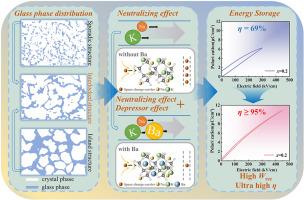Ultra-high energy storage efficiency achieved through the construction of interlocking microstructure and excitation of depressor effects
IF 12.7
1区 材料科学
Q1 ENGINEERING, MULTIDISCIPLINARY
引用次数: 0
Abstract
Glass-ceramic capacitors struggle to balance high energy storage efficiency (η>90 %) and sufficient breakdown field strength (Eb), hindering their use in energy storage. Interface polarization, caused by the accumulation of free charge, reduces breakdown strength. We prepared glass-ceramic materials with varying contents of the glass phase using traditional melting techniques, adjusting the glass content to enhance an interlocking structure between the glass and crystal phases, reducing Interface polarization. Divalent metal oxide BaO in the glass stimulated a depressor effect, filling gaps and increasing resistivity. The optimal composition (x = 0.2) achieved a 95 % energy storage efficiency and an energy storage density of 4.4 J/cm3 at 680 kV/cm, while x = 0.25 reached an ultra-high energy storage efficiency of 99 %. Increasing glass content reduced activation energy for Interface polarization (Ei) from 1.27 eV to 1.08 eV. Samples with x = 0.2 exhibited low dielectric loss (∼0.005), high dielectric constant (∼142), ultra-high power density (∼52.8 MW/cm3), and ultra-fast discharge speed (∼26 ns), suggesting future potential for high-performance glass-ceramic materials.

通过构建互锁微结构和激发减压器效应实现超高储能效率
玻璃陶瓷电容器很难在高储能效率(η>90 %)和足够的击穿场强(Eb)之间取得平衡,这阻碍了它们在储能领域的应用。自由电荷积累造成的界面极化会降低击穿强度。我们采用传统的熔化技术制备了玻璃相含量不同的玻璃陶瓷材料,通过调整玻璃含量来增强玻璃相与晶体相之间的互锁结构,从而减少界面极化。玻璃中的二价金属氧化物 BaO 激发了压抑效应,填充了间隙并提高了电阻率。最佳成分(x = 0.2)的储能效率为 95%,680 kV/cm 时的储能密度为 4.4 J/cm3,而 x = 0.25 的超高储能效率为 99%。玻璃含量的增加使界面极化活化能(Ei)从 1.27 eV 降至 1.08 eV。x = 0.2 的样品表现出低介电损耗(∼0.005)、高介电常数(∼142)、超高功率密度(∼52.8 MW/cm3)和超快放电速度(∼26 ns),这表明高性能玻璃陶瓷材料未来大有可为。
本文章由计算机程序翻译,如有差异,请以英文原文为准。
求助全文
约1分钟内获得全文
求助全文
来源期刊

Composites Part B: Engineering
工程技术-材料科学:复合
CiteScore
24.40
自引率
11.50%
发文量
784
审稿时长
21 days
期刊介绍:
Composites Part B: Engineering is a journal that publishes impactful research of high quality on composite materials. This research is supported by fundamental mechanics and materials science and engineering approaches. The targeted research can cover a wide range of length scales, ranging from nano to micro and meso, and even to the full product and structure level. The journal specifically focuses on engineering applications that involve high performance composites. These applications can range from low volume and high cost to high volume and low cost composite development.
The main goal of the journal is to provide a platform for the prompt publication of original and high quality research. The emphasis is on design, development, modeling, validation, and manufacturing of engineering details and concepts. The journal welcomes both basic research papers and proposals for review articles. Authors are encouraged to address challenges across various application areas. These areas include, but are not limited to, aerospace, automotive, and other surface transportation. The journal also covers energy-related applications, with a focus on renewable energy. Other application areas include infrastructure, off-shore and maritime projects, health care technology, and recreational products.
 求助内容:
求助内容: 应助结果提醒方式:
应助结果提醒方式:


